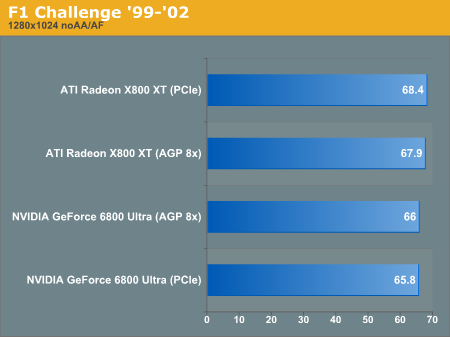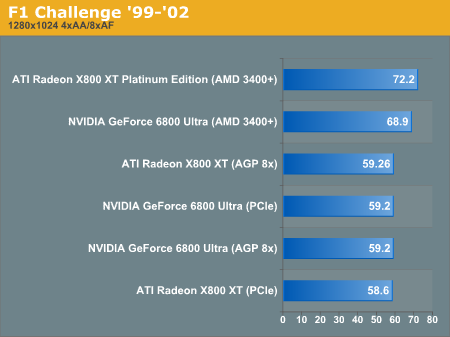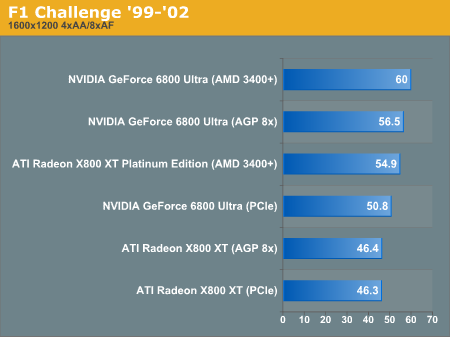Intel's 925X & LGA-775: Are Prescott 3.6 and PCI Express Graphics any Faster?
by Anand Lal Shimpi on June 21, 2004 12:05 PM EST- Posted in
- CPUs
F1 Challenge PCI Express Performance
Our F1 Challenge benchmark shows a slight advantage for the ATI PCI Express solution and a slight disadvantage for NVIDIA's, but when you look at the actual numbers, you'll see that there's once again no real world performance difference between the two interfaces.













39 Comments
View All Comments
Anand Lal Shimpi - Monday, June 21, 2004 - link
justlyI actually found out about the MTBF on Socket-478 at the launch of the Extreme Edition two IDFs ago. It's not that the motherboard will fail completely, it's that there may be some no-POST errors and (I'm guessing at this one) there may be some reduction in overall stability thanks to signal degradation depending on the issues with the contacts themselves. We easily can go through 20 insertions in a week at AT, and we encounter a *ton* of motherboards (especially those used as our regular testbeds) that just start acting up after a certain period of time. I even started to wonder how many of our random issues with stability are caused by things like the MTBF on CPU sockets...
I've already asked to talk to an engineer in greater depth about the issue, I'm hoping to have a response tomorrow. You and I both are concerned with making sure the right information gets out there; I published it because I trusted the source, but more information is definitely necessary.
I appreciate your last response tremendously, there's no offense taken - we're both out for the same goals.
Take care,
Anand
justly - Monday, June 21, 2004 - link
AnandI would be quite surprised if Intel can validate this claim. Either way I would be very interested in what they had to say.
I hope my previous post was not offensive, I just feel strongly (having 20+ years mechanical engineering experience) that Intel is pulling your leg.
The LGA-775 is a totally different animal. Since it does make contact at the tip of the pins it will be required to have a downward force exerted on the CPU. As for a reason to change the heatsinks force the answer is unclear. This reduction in force could be due to any number of reasons (prevent damage to motherboard or LGA-775 interface, more efficient heat sink design, or just that the extra force provided no tangible benefit) but I fail to see this being based on an electrical connection issue.
KF, before my last post I was trying to find a exploded view of a ZIF socket, nothing I found was clear enough to link to, but I do remember seeing some ZIF insertion numbers reaching as high as 10,000.
KF - Monday, June 21, 2004 - link
>You advise 'business users' to chose AMD...Also total nonsense, any entry
> level value processor will do, they don't need teraMips...
Besides the processors which are the subject of the article, AMD makes entry level value processors that outvalue, so your point is what? That if you want a sad POS processor, buy a Celeron? If performance is a consideration (which is why you might be reading the article), choose AMD. If not, choose AMD.
KF - Monday, June 21, 2004 - link
I too wondered how a ZIF (= Zero Insertion Force) socket's electrical contact could be affected by vertical pressure. The whole engineering premise is that vertical force should be irrelevant, I thought. But I have never seen an actual socket 478 disassembled.(Plenty of socket 370s and such, though) Do they have a contacts at the bottom in addition to the side squeeze contacts? Seems unlikely.Until this claim of 20 insertions MTBF, I was under the impression that a ZIFs life was indefinate. They use ZIFs (admittedly beefed up versions) for programming ROMs, and they must undergo thousands of insertions. So Intel engineers devised some ultra-super-pathetic duty spec just for Intel CPUs? Now, the heat sink mount I could believe would have 20 cycles MTBF.
>Who to trust? Anand and Intel... or some random web posters? Hmmm.. totally tough call there.
Not everyone is as blissfully uninformed as yourself. But loads of Anandtech posters have had direct experience with ZIFs, some having popped the tops off and removed a contact or two for mods, or at least seen the pics, and are not prepared to "trust" what is contrary to experience.
Pumpkinierre - Monday, June 21, 2004 - link
Thank you for your post Plagiarmaster. I often wondered why the excellent bandwidth of dual channel a64s did'nt translate into better encoding and thought software bias might have been the problem. It seems that the a64s have just about got it all.Cygni - Monday, June 21, 2004 - link
Who to trust? Anand and Intel... or some random web posters? Hmmm.. totally tough call there.ThePlagiarmaster - Monday, June 21, 2004 - link
OOPS..Re: my previous post, I should have said it COULD be up to 40%. Not that the difference IS 40%. It's just a rough guesstimate. Of course it could be less, but when you're talking hours and hours of a multipass rip (CCE anyone?) you need to be using the best app you can get for your chosen cpu correct? Maybe there is only the gain of breaking even. But even in that case you're talking 15-20% or so. That could mean hours. My guess is DVD2AVI is better on AMD because a guy like us wrote it (not some company, with big RD), and he likely did it on an AMD system.ThePlagiarmaster - Monday, June 21, 2004 - link
RE: this statement "DivX encoding is one of the few remaining performance advantages that Intel holds over AMD." from your article (and every article on cpu's). It's a bit misleading. Try using DVD2AVI as a front end and you will say the EXACT opposite, with an even larger victory for AMD. You can check any HardOCP review for this info. Since we all know Xmpeg loves Intel chips shouldn't you run the favorite frontend for AMD chips also? HardOCP shows each has a favorite (but don't use comparable results), but I wish you guys would go that ONE STEP FURTHER. Rip the same movie on Divx/DVD2AVI for AMD, and for Intel use Divx/Xmpeg. Who is REALLY FASTER? Your users should be told that anybody using xmpeg instead of dvd2avi while owning an AMD CPU is making a mistake (like waiting an extra 40% in time, for every rip-thats 20%loss for using xmpeg, and around 20%gain using dvd2avi). You might not be able to do this for all benchmarks, but here both frontends do the same exact job. Why not use the best for each cpu? It's the same amount of testing, just a different app for each CPU.I see this same problem with Musicmatch. It's not too kind on AMD cpu's. Personally I use EAC/Lame but I'm after CLEAN mp3's not speed. Finding the best app with mp3's for AMD I'll leave to someone else (Anandtech??). At any rate, saying Intel is faster in DIVX encoding is innacurate at best. Yet you keep repeating it in every review. Time to fix that I think.
Anand Lal Shimpi - Monday, June 21, 2004 - link
danidentityI'm looking into the overclocking lock, we hadn't heard anything about it until THG posted that article. At Computex we heard that manufacturers were having unusually low overclocking success with the 925X chipset but they weren't attributing it to a lock, rather issues with the chipset itself. We're working on finding out the full story right now, give us time and we'll let you know :)
Take care,
Anand
Anand Lal Shimpi - Monday, June 21, 2004 - link
justlyI believe the justification was that to maintain proper long term connection between those pins and the contacts, some of that ~40 lbs of pressure was necessary. If you try to install something in the new LGA-775 socket you do notice that the lever puts a *lot* of force on the pins, and that the heatsink puts a lot less force on the chip.
Intel comes up with these numbers on their own through extensive reliability and stress testing, much more than can be reproduced within our labs. I will push Intel further on the issue to see if I can get some clarification/explanation as to how they believe the pressure from the heatsink helped, because I do agree that it does seem suspect but they were convinced of it.
Take care,
Anand